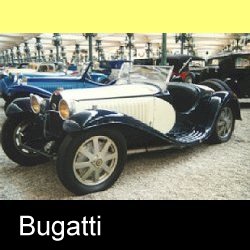|
Ettore Bugatti werd geboren in 1881 in Milaan in een kunstzinnige familie. Hij had meer interesse in mechanica dan in de grafische sector en in 1900 (hij was toen dus 19) bouwde hij met steun van een Italiaanse graaf zijn eerste auto met een 4 cilinder motor van 3.054 cc (90 x 120). Baron De Dietrich zag dit product en was onder de indruk. Hij bood de jonge Bugatti een positie aan in zijn fabriek in Niederbronn. Vanaf 1902 werkte hij daar 2 of 3 jaar aan auto’s met 4 cilinder motoren van 5.308 cc (114 x 130), die werden verkocht onder de naam De Dietrich-Bugatti. Rond 1904 ging Ettore, toen bleek dat de auto’s geen commercieel succes waren, weg bij De Dietrich en trok naar zijn vriend Emile Mathis in Straatsburg. Met Mathis bouwde Bugatti de Hermes auto, die erg op de De Dietrich leek. Ook deze liaison hield niet lang stand en in 1906 ging Bugatti naar de Deutz fabriek in Keulen om daar auto’s te ontwerpen en te produceren. Gedurende de Deutz dagen bouwde Bugatti in zijn eigen vrije tijd en in de kelder van zijn huis een kleine auto met 4 cilinder motor van 1.131 cc (60 x 100). Dit prototype, dat Type 10 werd genoemd, bestaat nog steeds. Eind 1909 was hij in staat om met financiele hulp van een weldoener zijn eigen fabriek op te richten in Molsheim. Dat was het echte begin van het Bugatti tijdperk. In 1910 bouwde hij maar een paar auto’s, maar op de Parijse Autosalon van 1910 ontving hij veel positieve kritiek. Een opvallend design uit de vroege jaren was het ontwerp dat hij in 1913 voor Peugeot maakte (de Peugeot Bébé Type BP1 met 4 cilinder motor van 855 cc, 6 PK). Dan maken we nu een sprong naar de auto op de foto, voor velen de mooiste Bugatti ooit gebouwd, de Type 55 Roadster van 1932. De auto had een 8 cilinder motor van 2.262 cc en leverde 130 PK, goed voor 180 km/u. De motor had 3 kleppen per cilinder en het prachtige koetswerk was een ontwerp van Ettore’s zoon Jean. Van dit Type 55 zijn maar 38 exemplaren gebouwd en behalve dat hij heel mooi is, is hij dus ook heel zeldzaam. Dit exemplaar maakt deel uit van de collectie van het Franse Nationaal Automuseum te Mulhouse.
|
Ettore Bugatti was born in Milan in 1881 in an art minded family. Graphic arts were not to his liking, however, mechanics was more his cup of tea. In 1900, at the age of 19, backed by an Italian count, he built his first car with a 4 cilinder engine of 3,054 cc (90 x 120 mm). Baron De Dietrich saw the car and was very impressed. He offered Bugatti a position in his factory in Niederbronn. From 1902 he worked there for 2 or 3 years on cars with 4 cilinder engines of 5,308 cc capacity (114 x 130 mm), which were sold under the name De Dietrich-Bugatti. At about 1904, when it became clear the cars were no financial succes, Bugatti left De Dietrich and went to Strasbourg to his friend Emile Mathis. Together they built the Hermes car, which was very much like the De Dietrich. This partnership, too, did not last long and in 1906 Bugatti went to the Deutz factory in Cologne to build and produce cars there. During the Deutz days, in the cellar of his home, in his spare time, he built a small car with a 4 cilinder engine of 1,131 cc capacity (60 x 100 mm). This prototype, the Type 10, still exists. Towards the end of 1909 he was able, backed financially, to found his own car factory at Molsheim, near Strasbourg. This was the real beginning of the Bugatti era. In 1910 he only built a few cars, but his stand at the 1910 Paris Salon evoked many positive reactions. A remarkable design from his early years is the Peugeot Bébé Type BP1 from 1913, which was equipped with a 4 cilinder engine of 855 cc developing 6 HP. We now take a giant step in history to the car in the picture, the unequalled Type 55 Roadster of 1932 which makes part of the magnificent collection of the French National Motor Museuam at Mulhouse. It is arguably the most beautiful Bugatti ever built and it is equipped with an 8 cilinder of 2,262 cc capacity, developing 130 HP which could propel the car with a speed of little over 110 mph. It had three valves per cilinder, two inlet and one exhaust. The bodywork was designed by Ettore’s son Jean. Only 38 cars of this type were built. That does not only make the car very beautiful, but very rare as well.
|


